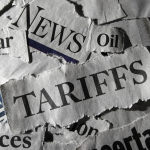The 18_19 financial year has come and gone and it was definitely an interesting twelve months...
A good first quarter (Jul – Sep 18), a very negative second and then the last two quarters (Jan- Jun 19) have been very positive. In the last two quarters, the US S&P 500 rose by over 18% and the Australian ASX 200 rose by over 17%.
Back in January, we were ‘cautiously’ optimistic, but were certainly not expecting to see the markets accelerate the way they have. Now in August, we are simply cautious.
This is not just ‘the vibe’ as ‘driving by feel’ can be hazardous. If we had used sentiment to drive our investment decisions, we would have been far more negative after the December 18 quarter. We have often talked about ‘news’ vs analysis and while there was lot of doomsayers in December last year, the analysts we were talking to, were positive that some heat had left the markets and that there were some good quality equities at reasonable prices.
The macro environment had also changed with the United States Federal Reserve changing its position on interest rates (moving away from tightening i.e. increasing rates to easing). China and the US were also backing away from trade tensions, which had a number of positive flow on effects. There were tensions building in Iran but North Korea was settling down so overall the start of 2019 looked more positive. The UK and Europe were still in Brexit negotiations but the outcome and the impacts were still very much up in the air.
Closer to home we had an election looming so expected little from markets but not necessarily negative movement. Recession fears were the biggest concern but arguably, this had been factored into prices in the December quarter.
Prudently, we did talk to many clients through this period, especially those who had benefited from the great rally since 2008, and suggested taking profits and utilising some conservative options. This strategy is called ‘averaging’ your way out of the markets.
- Additionally, clients in our model portfolios are reweighted back to their strategic benchmarks each quarter. This means if your asset allocation was 65% growth and 35% defensive at 1 January then at 31 March, you are reweighted back to those benchmarks. If the growth portion of your portfolio had grown to 68% of your total portfolio then we would reweight it back to 65% and the profits would go into defensive assets. If markets decline then we would be doing the opposite and selling down defensive assets to buy growth.
- Our underlying growth managers also take on additional cash when they are concerned about excessive valuations.
In short, there are a number of strategies being implemented behind the scenes to cushion the impacts of market fluctuations.
Now in August 2019 we have a very different macro-economic and geo-political backdrop.
The US has reignited its trade war with China by threatening to increase tariffs on a number of Chinese imports and the Chinese have retaliated by cancelling their imports of US agricultural products.
Trade wars are not just bad for the participants but also for all the suppliers in the chain. We are one of those suppliers and so are many of our trading partners – Japan, South Korea, India and Hong Kong.
Additionally with Boris Johnson now the leader of the UK government it would look increasingly likely that the only exit the UK will have is a ‘no deal’ Brexit. The problem here is uncertainty and the very real likelihood that the EU may have bigger issues with Italy. Italy is the third largest bond market in the world and polls (if we can believe them) indicate Italy may install a ‘hard right’ government. We have already seen polarising governments installed in Poland, Czech Republic and Hungary and there is an increasingly aggressive regime in Russia.
Nationalist issues are the blunt instrument being used to rally support and anti-immigration and anti-European Union sentiment is attractive to citizens who have been suffering under the austerity measures since the GFC.
We then have the concerns with Iran and the Strait of Hormuz.
Trade embargos to impede Iran’s nuclear weapons program are hurting the Iranian economy, which is heavily reliant on oil exports to sustain its wealth. The shipping lane in the Strait is only approximately 3kms wide (the Strait itself is 33kms wide at its narrowest point).
Why is it important? 17 percent of global oil production and 33 percent of the world’s liquefied natural gas (LNP) travels through it. Threats to block this supply line are taken very seriously and the United States, 5th Fleet, is tasked with protecting the shipping lanes. The US however, is almost self-sufficient and has built vast oil reserves, and there is an argument, they are no longer interested in settling these disputes and will leave it to the EU and the UK to sort out.
There are more issues like China and Hong Kong, inflation in Argentina, conflicts in Northern Africa and immigration through the Mexican border. Amazingly, US Border patrols apprehended 688,000 illegal entrants via the Mexican border between October 2018 and June 2019 (9 months and that is who they caught not how many entered).
So, we have a lot of geopolitical issues and now we have some of the most expensive share markets in recorded history. US markets are at Price to Valuation ratios (P/Es) almost as high as they have ever been.
The outlier in
this is discussion is that I can share this information with you, as it is
‘known’. In portfolio theory, this is all
factored in, or at least most of it, to the current prices.
So is it?
The truth is, that if investing was as simple as pointing to one issue and following that direction, we would all be a lot wealthier.
I have given you a large number of negatives and by ‘framing’ it the way I have, you would be forgiven for looking for the exit.
Unfortunately, there is always bad news somewhere.
On the flip side, Boris Johnson is very clear in his position on Brexit and a decision will be made on October 31 (maybe).
Nationalism can lead to conflict however, business is global and every government needs money. Large corporates do have a lot of say in how the economy is managed and don’t like conflicts.
The Italians may want out of the EU, but who is going to refinance their huge government debt.
The US/China trade talks have a way to run and the cancelling of agricultural orders included a large amount of soy beans used to feed pigs. China is the world’s top pig producer and its pork industry has been ravaged by African swine fever. This might suggest why this was ‘timely’.
Iran and Russia are allies and the Hormuz issue is by no means over but the analysts would suggest the US Government has no real interest in starting a conflict in the Middle East and not in an election year!
Where to with investments.
While writing this, today markets have tumbled after big losses in Wall Street overnight (15 August 19).
The Australian All Ordinaries has closed at 6405.6. We actually started the year, 2 January at 5625.6.
The US S&P 500 closed this morning (our time) at 2840.6. At January 2, 2019 this index was 2510.03.
The press will no doubt talk about billions of dollars in losses and possibly ignore the amazing growth we have seen this year.
We, as I have said, are cautious and fully accept that markets are fully priced hence we have been de-risking individuals in aggressive portfolios and our model management has been triggering its automatic downside protection. Our active managers have been holding more cash than usual and took these positions in early July.
The current reason for market volatility is ‘Recession Fears’ and there is certainly a case for this, both here, in the US and globally.
The market is moving up and down dramatically on every piece of positive and negative news so it is indeed boiling.
Warren Buffet has said, “The Stock Market is a device for transferring money from the impatient to the patient.”
There will be buying opportunities in the coming months and we are by no means idle spectators when we see this sort of volatility. There is no rush to jump into this market and if you have de-risked, history would suggest you can wait for a clear direction before making a decision to increase risk.
We regularly state we are wary of ‘Guru’ calls and will rely on analysis rather than news.
As always, if you have any concerns, please contact us. We are here to help and there are steps we can take, to alleviate concerns.
Best Regards
Paul Forbes
CEO – RFS Advice
















